Effect of the Release of Gravel Elements on Soil Nutrients and Jujube Fruit Yield under Wet-and-Dry Cycles
Abstract
:1. Introduction
2. Materials and Methods
2.1. Soil, Gravel, Seedlings, and Water Samples
2.2. Mineralogy and Microscopy
2.3. Chemical Composition
2.4. Experimental Setup
2.5. Experimental Treatments
2.6. Statistical Analysis
3. Results
3.1. Gravel Mineralogy and Microscopy
3.2. Chemical Characterization of Elements in Water, Gravel, and Soil
3.3. Accumulation and Transport of Chemical Elements in Soils
3.4. Enrichment and Depletion of Soil Elements
3.5. Growth and Yield Indicators of Jujube Tree
4. Discussion
4.1. Petrographic and Geochemical Characteristics of the Gravels
4.2. Differences in Soil Nutrients and Jujube Yield among Treatments
4.3. Difference between Soil Elements under Bare Soil and Gravel Mulch
4.4. Chemical Elements Affecting Soil Nutrients and Jujube Growth and Yield
5. Conclusions
Author Contributions
Funding
Data Availability Statement
Acknowledgments
Conflicts of Interest
References
- Tilman, D.; Balzer, C.; Hill, J.; Befort, B.L. Global food demand and the sustainable intensification of agriculture. Proc. Natl. Acad. Sci. USA 2011, 108, 20260–20264. [Google Scholar] [CrossRef] [PubMed] [Green Version]
- Du, Y.; Cui, B.; Zhang, Q.; Wang, Z.; Sun, J.; Niu, W. Effects of manure fertilizer on crop yield and soil properties in China: A meta-analysis. Catena 2020, 193, 104617. [Google Scholar] [CrossRef]
- Yu, C.; Huang, X.; Chen, H.; Godfray, H.C.J.; Wright, J.S.; Hall, J.W.; Gong, P.; Ni, S.; Qiao, S.; Huang, G.; et al. Managing nitrogen to restore water quality in China. Nature 2019, 567, 516–520. [Google Scholar] [CrossRef]
- Ramos, C.G.; Querol, X.; Oliveira, M.L.S.; Pires, K.; Kautzmann, R.M.; Oliveira, L.F.S. A preliminary evaluation of volcanic rock powder for application in agriculture as soil a remineralizer. Sci. Total Environ. 2015, 512–513, 371–380. [Google Scholar] [CrossRef] [PubMed]
- Dalmora, A.C.; Ramos, C.G.; Oliveira, M.L.S.; Oliveira, L.F.S.; Schneider, I.A.H.; Kautzmann, R.M. Application of andesite rock as a clean source of fertilizer for eucalyptus crop: Evidence of sustainability. J. Clean. Prod. 2020, 256, 120432. [Google Scholar] [CrossRef]
- Chen, G.; Shah, K.J.; Shi, L.; Chiang, P.-C.; You, Z. Red soil amelioration and heavy metal immobilization by a multi-element mineral amendment: Performance and mechanisms. Environ. Pollut. 2019, 254, 112964. [Google Scholar] [CrossRef] [PubMed]
- Ramos, C.G.; Querol, X.; Dalmora, A.C.; de Pires, K.C.J.; Schneider, I.A.H.; Oliveira, L.F.S.; Kautzmann, R.M. Evaluation of the potential of volcanic rock waste from southern Brazil as a natural soil fertilizer. J. Clean. Prod. 2017, 142, 2700–2706. [Google Scholar] [CrossRef]
- Li, X.-Y. Gravel Csand mulch for soil and water conservation in the semiarid loess region of northwest China. Catena 2003, 52, 105–127. [Google Scholar] [CrossRef]
- Qiu, Y.; Xie, Z.K.; Wang, Y.J.; Ren, J.L.; Malhi, S.S. Influence of gravel mulch stratum thickness and gravel grain size on evaporation resistance. J. Hydrol. 2014, 519, 1908–1913. [Google Scholar] [CrossRef]
- Qiu, Y.; Xie, Z.K.; Wang, Y.J.; Malhi, S.S.; Ren, J.L. Long-term effects of gravel-sand mulch on soil organic carbon and nitrogen in the Loess Plateau of northwestern China. J. Arid Land 2015, 7, 46–53. [Google Scholar] [CrossRef]
- Oukaira, A.; Benelhaouare, A.Z.; Kengne, E.; Lakhssassi, A. FPGA-Embedded Smart Monitoring System for Irrigation Decisions Based on Soil Moisture and Temperature Sensors. Agronomy 2021, 11, 1881. [Google Scholar] [CrossRef]
- Zhang, M.; Yang, L.; Hao, R.Q.; Bai, X.X.; Wang, Y.; Yu, X. Drought-tolerant plant growth-promoting rhizobacteria isolated from jujube (Ziziphus jujuba) and their potential to enhance drought tolerance. Plant Soil 2020, 452, 423–440. [Google Scholar] [CrossRef]
- Li, Q.; Zhang, S.Q. Impacts of Recent Climate Change on Potato Yields at a Provincial Scale in Northwest China. Agronomy 2020, 10, 426. [Google Scholar] [CrossRef] [Green Version]
- Wang, L.; Qiu, Y.N.; Han, Z.Y.; Xu, C.; Wu, S.Y.; Wang, Y.; Holmgren, M.; Xu, Z.W. Climate, topography and anthropogenic effects on desert greening: A 40-year satellite monitoring in the Tengger desert, northern China. Catena 2022, 209, 105851. [Google Scholar] [CrossRef]
- Korchagin, J.; Caner, L.; Bortoluzzi, E.C. Variability of amethyst mining waste: A mineralogical and geochemical approach to evaluate the potential use in agriculture. J. Clean. Prod. 2019, 210, 749–758. [Google Scholar] [CrossRef]
- Antoniadis, V.; Levizou, E.; Shaheen, S.M.; Ok, Y.S.; Sebastian, A.; Baum, C.; Prasad, M.N.V.; Wenzel, W.W.; Rinklebe, J. Trace elements in the soil-plant interface: Phytoavailability, translocation, and phytoremediation CA review. Earth Sci. Rev. 2017, 171, 621–645. [Google Scholar] [CrossRef]
- Maher, K.; Chamberlain, C.P. Hydrologic Regulation of Chemical Weathering and the Geologic Carbon Cycle. Science 2014, 343, 6178. [Google Scholar] [CrossRef]
- Ciceri, D.; de Oliveira, M.; Stokes, R.M.; Skorina, T.; Allanore, A. Characterization of potassium agrominerals: Correlations between petrographic features, comminution and leaching of ultrapotassic syenites. Miner. Eng. 2017, 102, 42–57. [Google Scholar] [CrossRef]
- Burghelea, C.; Zaharescu, D.G.; Dontsova, K.; Maier, R.; Huxman, T.; Chorover, J. Mineral nutrient mobilization by plants from rock: Influence of rock type and arbuscular mycorrhiza. Biogeochemistry 2015, 124, 187–203. [Google Scholar] [CrossRef]
- Swoboda, P.; Doring, T.F.; Hamer, M. Remineralizing soils? The agricultural usage of silicate rock powders: A review. Sci. Total Environ. 2022, 807, 150976. [Google Scholar] [CrossRef]
- He, S.; Wu, J.H. Hydrogeochemical Characteristics, Groundwater Quality, and Health Risks from Hexavalent Chromium and Nitrate in Groundwater of Huanhe Formation in Wuqi County, Northwest China. Expos. Health 2019, 11, 125–137. [Google Scholar] [CrossRef]
- Tabelin, C.B.; Igarashi, T.; Villacorte-Tabelin, M.; Park, I.; Opiso, E.M.; Ito, M.; Hiroyoshi, N. Arsenic, selenium, boron, lead, cadmium, copper, and zinc in naturally contaminated rocks: A review of their sources, modes of enrichment, mechanisms of release, and mitigation strategies. Sci. Total Environ. 2018, 645, 1522–1553. [Google Scholar] [CrossRef] [PubMed]
- Tan, J.Q.; Weniger, P.; Krooss, B.; Merkel, A.; Horsfield, B.; Zhang, J.C.; Boreham, C.J.; van Graas, G.; Tocher, B.A. Shale gas potential of the major marine shale formations in the Upper Yangtze Platform, South China, Part II: Methane sorption capacity. Fuel 2014, 129, 204–218. [Google Scholar] [CrossRef]
- Hatano, N.; Yoshida, K.; Sasao, E. Effects of grain size on the chemical weathering index: A case study of Cheek for Neogene fluvial sediments in southwest Japan. Sediment. Geol. 2019, 386, 1–8. [Google Scholar] [CrossRef]
- Du, Y.; Luo, K.; Ni, R.; Hussain, R. Selenium and hazardous elements distribution in plant–soil–water system and human health risk assessment of Lower Cambrian, Southern Shaanxi, China. Environ. Geochem. Health 2018, 40, 2049–2069. [Google Scholar] [CrossRef]
- Zhao, Z.; Wang, H.; Wang, C.; Li, W.; Chen, H.; Deng, C. Changes in reference evapotranspiration over Northwest China from 1957 to 2018: Variation characteristics, cause analysis and relationships with atmospheric circulation. Agric. Water Manag. 2020, 231, 105958. [Google Scholar] [CrossRef]
- Ma, Y.J.; Li, X.Y. Water accumulation in soil by gravel and sand mulches: Influence of textural composition and thickness of mulch layers. J. Arid Environ. 2011, 75, 432–437. [Google Scholar] [CrossRef]
- Dessert, C.l.; Gaillardet, J.; Dupre, B.; Schott, J.; Pokrovsky, O.S. Fluxes of high- versus low-temperature water Crock interactions in aerial volcanic areas: Example from the Kamchatka Peninsula, Russia. Geochim. Cosmochim. Acta 2009, 73, 148–169. [Google Scholar] [CrossRef]
- Li, X.Y.; Shi, P.J.; Liu, L.Y.; Gao, S.Y.; Wang, X.S.; Cheng, L.S. Influence of pebble size and cover on rainfall interception by gravel mulch. J. Hydrol. 2005, 312, 70–78. [Google Scholar] [CrossRef]
- Liu, J.-H.; Zhang, Q.W.L.; Wang, J.; Zhang, H.C.G.; Wu, C.-M. Metamorphic evolution and SIMS U CPb geochronology of orthopyroxene-bearing high-P semipelitic granulite in the Fuping area, middle Trans-North China Orogen. J. Metamorph. Geol. 2021, 39, 297–320. [Google Scholar] [CrossRef]
- Smits, M.M.; Hoffland, E.; Jongmans, A.G.; van Breemen, N. Contribution of mineral tunneling to total feldspar weathering. Geoderma 2005, 125, 59–69. [Google Scholar] [CrossRef]
- Romer, R.L.; Kroner, U. Phanerozoic tin and tungsten mineralization-Tectonic controls on the distribution of enriched protoliths and heat sources for crustal melting. Gondwana Res. 2016, 31, 60–95. [Google Scholar] [CrossRef]
- Manning, D.A.C.; Theodoro, S.H. Enabling food security through use of local rocks and minerals. Extr. Ind. Soc. 2020, 7, 480–487. [Google Scholar] [CrossRef]
- Liu, X.Z.; Manevski, K.; Liu, F.L.; Andersen, M.N. Biomass accumulation and water use efficiency of faba bean-ryegrass intercropping system on sandy soil amended with biochar under reduced irrigation regimes. Agric. Water Manag. 2022, 273, 107905. [Google Scholar] [CrossRef]
- Lidelow, S.; Macsik, J.; Carabante, I.; Kumpiene, J. Leaching behaviour of copper slag, construction and demolition waste and crushed rock used in a full-scale road construction. J. Environ. Manag. 2017, 204, 695–703. [Google Scholar] [CrossRef]
- Plata, L.G.; Ramos, C.G.; Oliveira, M.L.S.; Oliveira, L.F.S. Release kinetics of multi-nutrients from volcanic rock mining by-products: Evidences for their use as a soil remineralizer. J. Clean. Prod. 2021, 279, 123668. [Google Scholar] [CrossRef]
- Kuzin, A.; Solovchenko, A. Essential Role of Potassium in Apple and Its Implications for Management of Orchard Fertilization. Plants 2021, 10, 2624. [Google Scholar] [CrossRef]
- Rahman, M.M.; Salleh, M.A.M.; Rashid, U.; Ahsan, A.; Hossain, M.M.; Ra, C.S. Production of slow release crystal fertilizer from wastewaters through struvite crystallization—A review. Arab. J. Chem. 2014, 7, 139–155. [Google Scholar] [CrossRef] [Green Version]
- Wu, S.; Zhao, L.; Wang, L.; Huang, X.; Zhang, Y.; Feng, Z.; Cui, D. Simultaneous recovery of rare earth elements and phosphorus from phosphate rock by phosphoric acid leaching and selective precipitation: Towards green process. J. Rare Earths 2019, 37, 652–658. [Google Scholar] [CrossRef]
- Dai, Z.; Fei, L.; Huang, D.; Zeng, J.; Chen, L.; Cai, Y. Coupling effects of irrigation and nitrogen levels on yield, water and nitrogen use efficiency of surge-root irrigated jujube in a semiarid region. Agric. Water Manag. 2019, 213, 146–154. [Google Scholar] [CrossRef]
- Da Silva, Y.; do Nascimento, C.W.A.; Biondi, C.M.; van Straaten, P.; da Silva, Y.; de Souza, V.S.; de Araujo, J.C.T.; Alcantara, V.C.; da Silva, F.L.; da Silva, R. Concentrations of major and trace elements in soil profiles developed over granites across a climosequence in northeastern Brazil. Catena 2020, 193, 104641. [Google Scholar] [CrossRef]
- Wang, H.; Wang, X.; Peng, B. Using an improved Si-rich husk ash to decrease inorganic arsenic in rice grain. Sci. Total Environ. 2022, 803, 150102. [Google Scholar] [CrossRef] [PubMed]
- Zhang, Q.; Wang, Z.; Xia, S.; Zhang, G.; Li, S.; Yu, D.; Yu, X. Hydrologic-induced concentrated soil nutrients and improved plant growth increased carbon storage in a floodplain wetland over wet-dry alternating zones. Sci. Total Environ. 2022, 822, 153512. [Google Scholar] [CrossRef] [PubMed]
- Song, T.; Das, D.; Hu, Q.; Yang, F.; Zhang, J. Alternate wetting and drying irrigation and phosphorus rates affect grain yield and quality and heavy metal accumulation in rice. Sci. Total Environ. 2021, 752, 141862. [Google Scholar] [CrossRef] [PubMed]
- Chen, Z.; Liu, X.; Ai, Y.; Chen, J.; Luo, X.; Yang, S.; Kang, Z.; Zhong, S.; Li, W. How backfill soil type influencing on Cd and Pb migration in artificial soil on railway rock-cut slopes. Sci. Total Environ. 2019, 665, 531–537. [Google Scholar] [CrossRef]
- Ramos, C.G.; Dalmora, A.C.; Kautzmann, R.M.; Hower, J.; Dotto, G.L.; Oliveira, L.F.S. Sustainable Release of Macronutrients to Black Oat and Maize Crops from Organically-Altered Dacite Rock Powder. Nat. Resour. Res. 2021, 30, 1941–1953. [Google Scholar] [CrossRef]
- Haque, A.N.A.; Uddin, M.K.; Sulaiman, M.F.; Amin, A.M.; Hossain, M.; Aziz, A.A.; Mosharrof, M. Impact of Organic Amendment with Alternate Wetting and Drying Irrigation on Rice Yield, Water Use Efficiency and Physicochemical Properties of Soil. Agronomy 2021, 11, 1529. [Google Scholar] [CrossRef]
- Liu, L.; Song, Z.; Li, Q.; Ellam, R.M.; Tang, J.; Wang, Y.; Sarkar, B.; Wang, H. Accumulation and partitioning of toxic trace metal(loid)s in phytoliths of wheat grown in a multi-element contaminated soil. Environ. Pollut. 2022, 294, 118645. [Google Scholar] [CrossRef]
- Sunagawa, S.; Coelho, L.P.; Chaffron, S.; Kultima, J.R.; Labadie, K.; Salazar, G.; Djahanschiri, B.; Zeller, G.; Mende, D.R.; Alberti, A.; et al. Structure and function of the global ocean microbiome. Science 2015, 348, 1261359. [Google Scholar] [CrossRef] [Green Version]
- Jordan-Meille, L.; Holland, J.E.; McGrath, S.P.; Glendining, M.J.; Thomas, C.L.; Haefele, S.M. The grain mineral composition of barley, oat and wheat on soils with pH and soil phosphorus gradients. Eur. J. Agron. 2021, 126, 126281. [Google Scholar] [CrossRef]
- Roy, S.; Leban, J.-M.; Zeller, B.; van der Heijden, G.; Reichard, A.; Gehin, M.-C.; Santenoise, P.; Saint-Andre, L. Removing harvest residues from hardwood stands affects tree growth, wood density and stem wood nutrient concentration in European beech (Fagus sylvatica) and oak (Quercus spp.). For. Ecosyst. 2022, 9, 100014. [Google Scholar] [CrossRef]
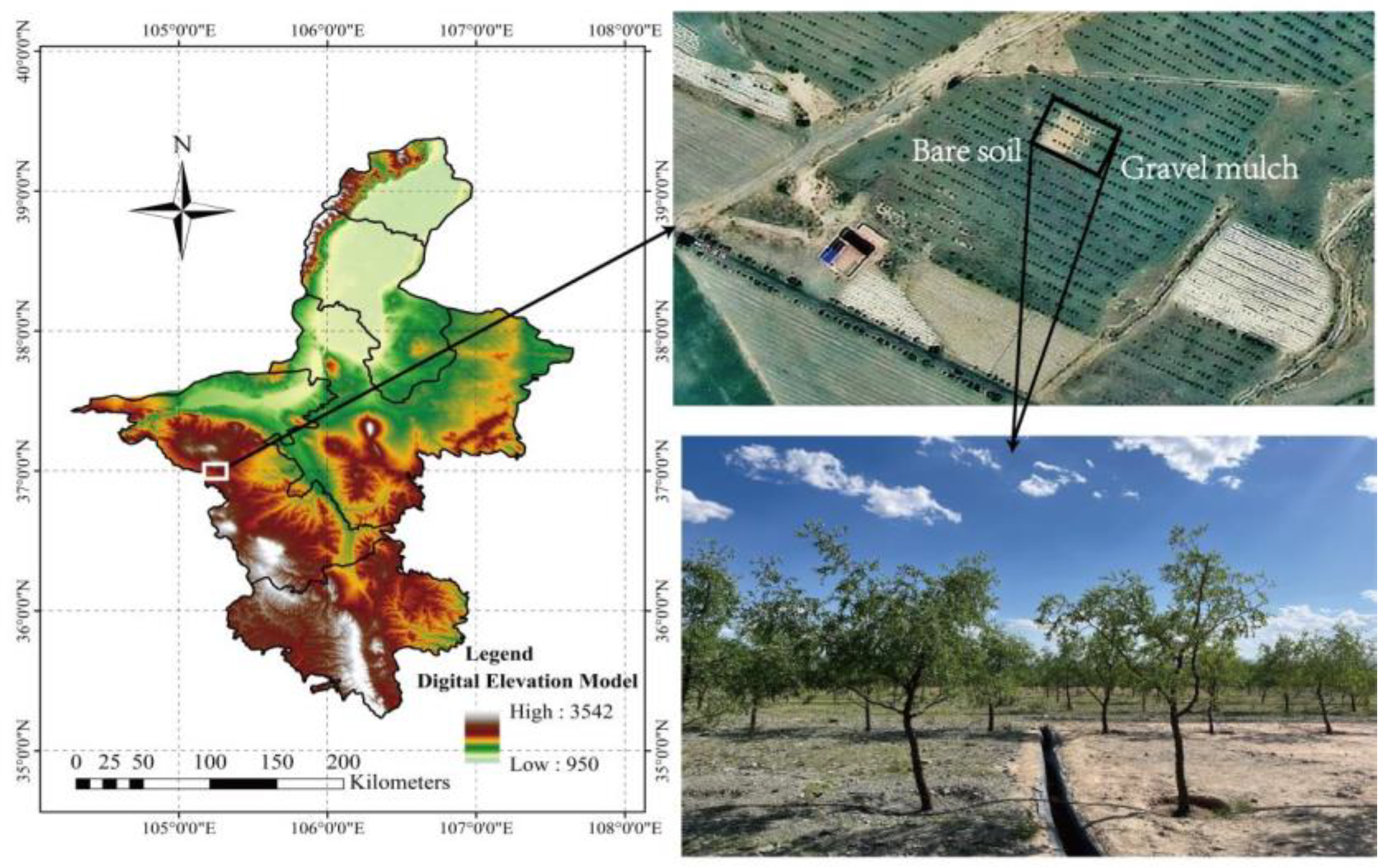
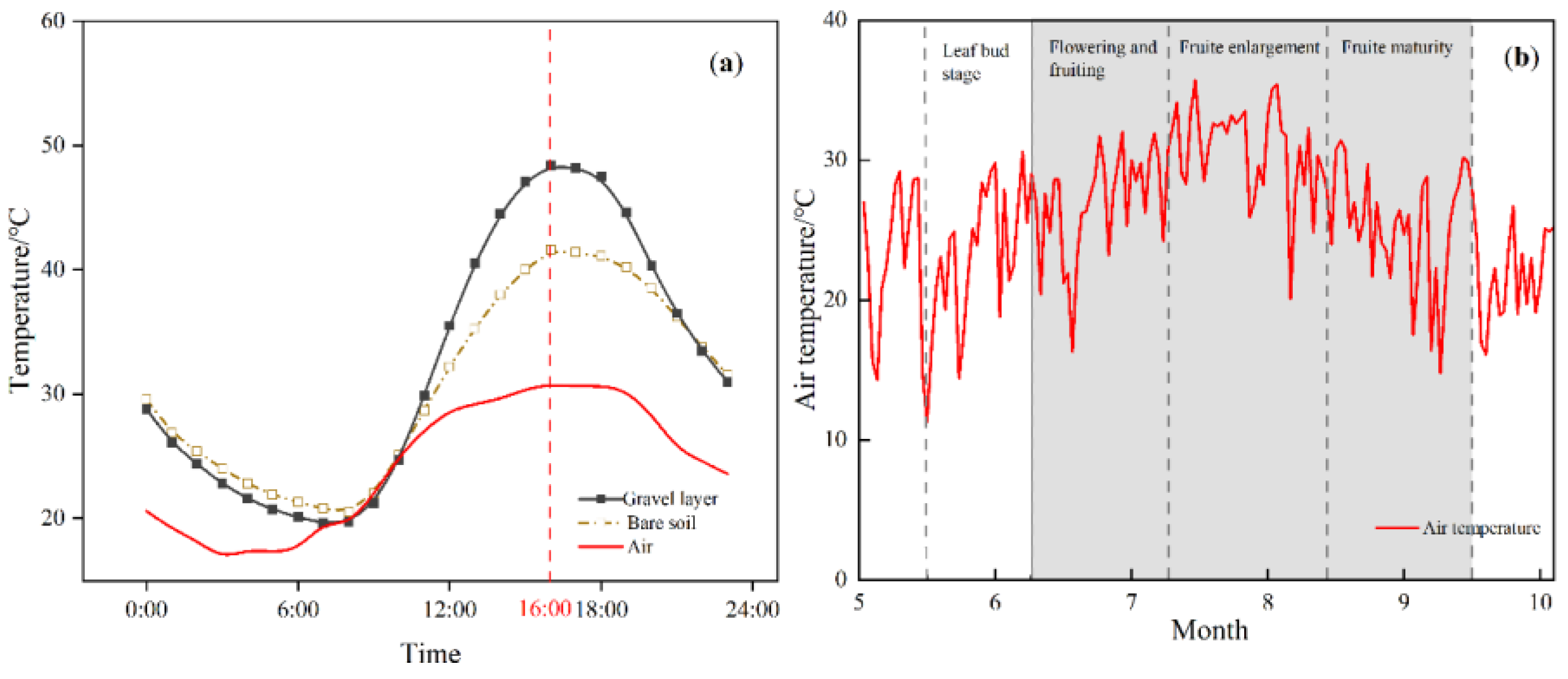
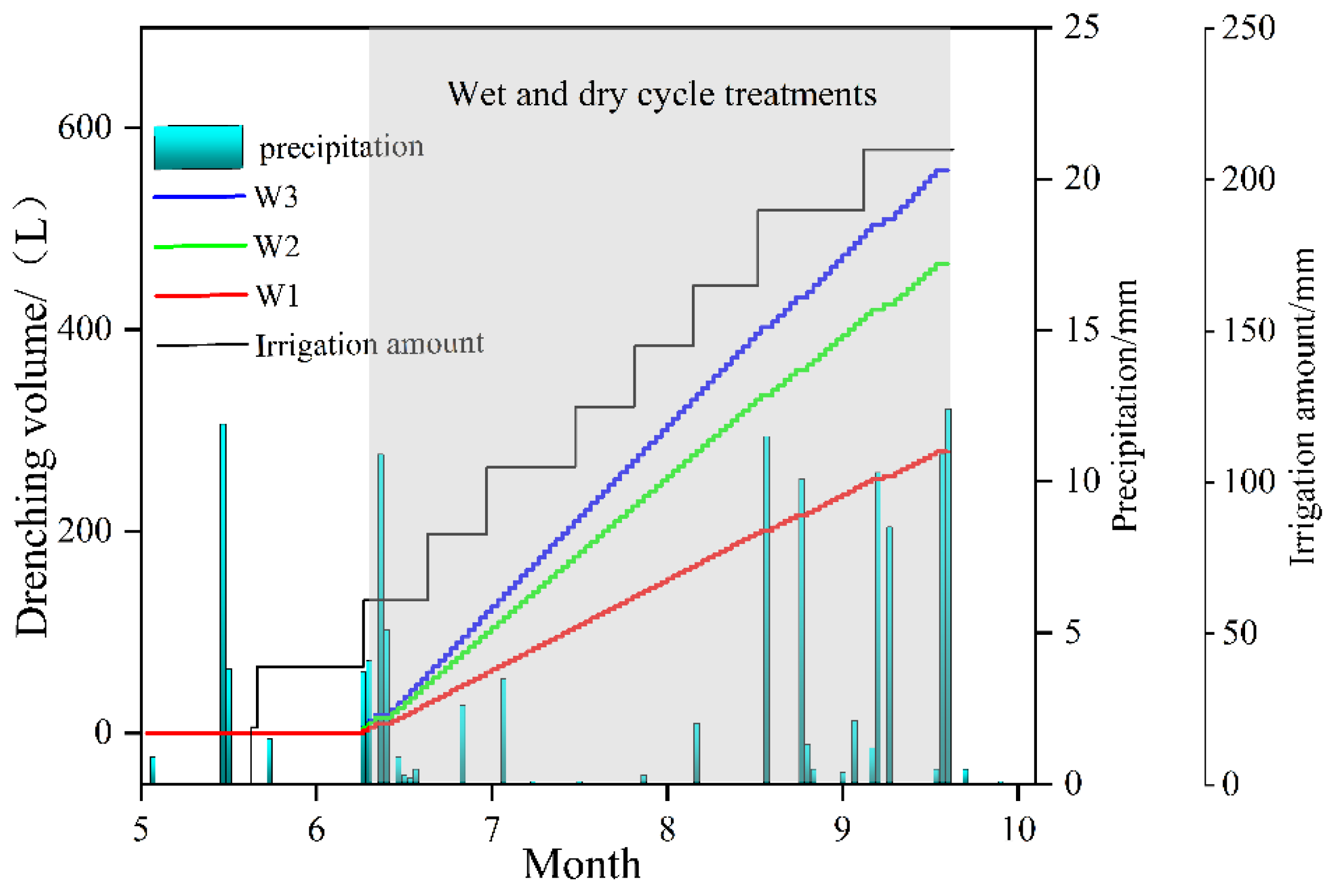
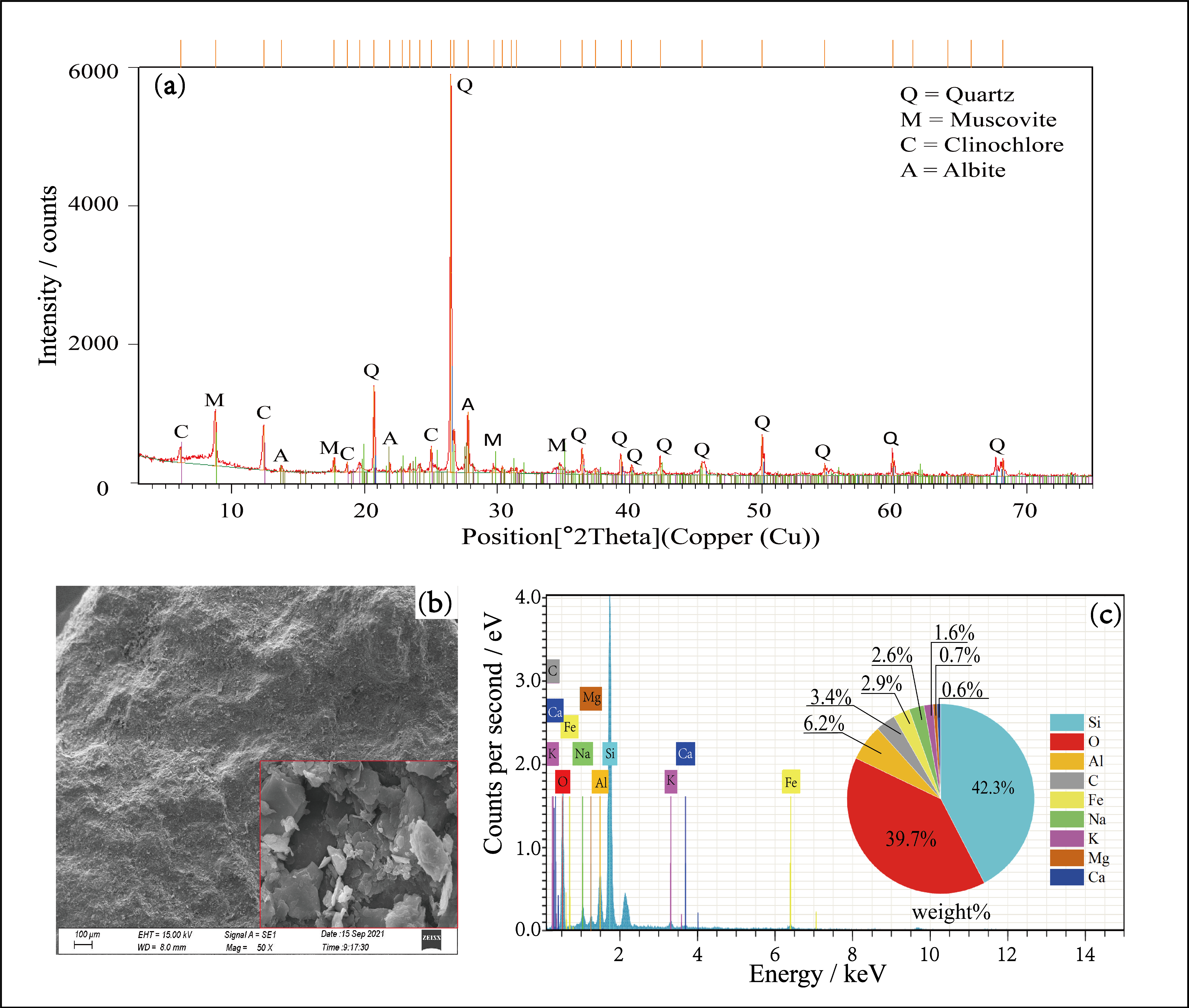
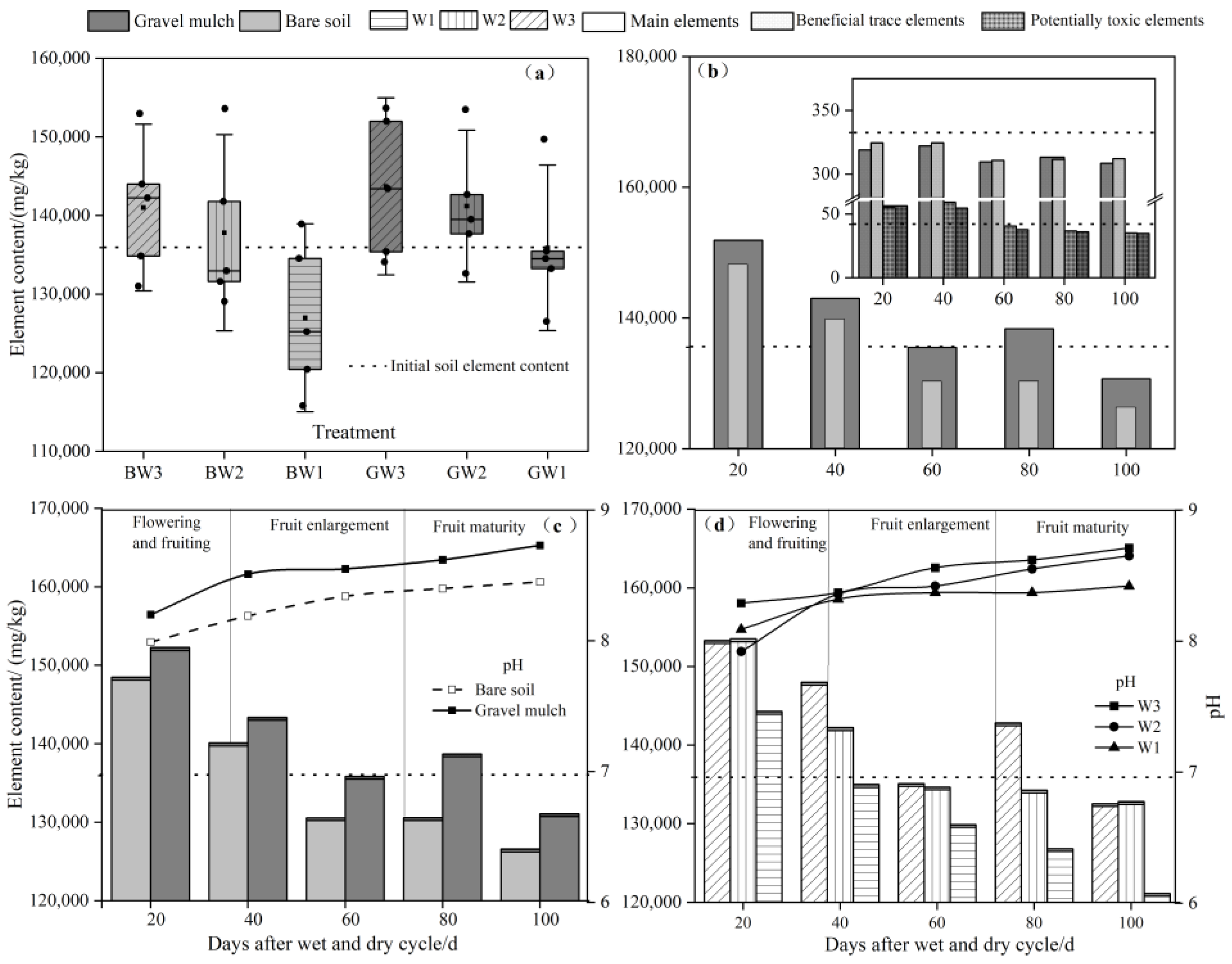
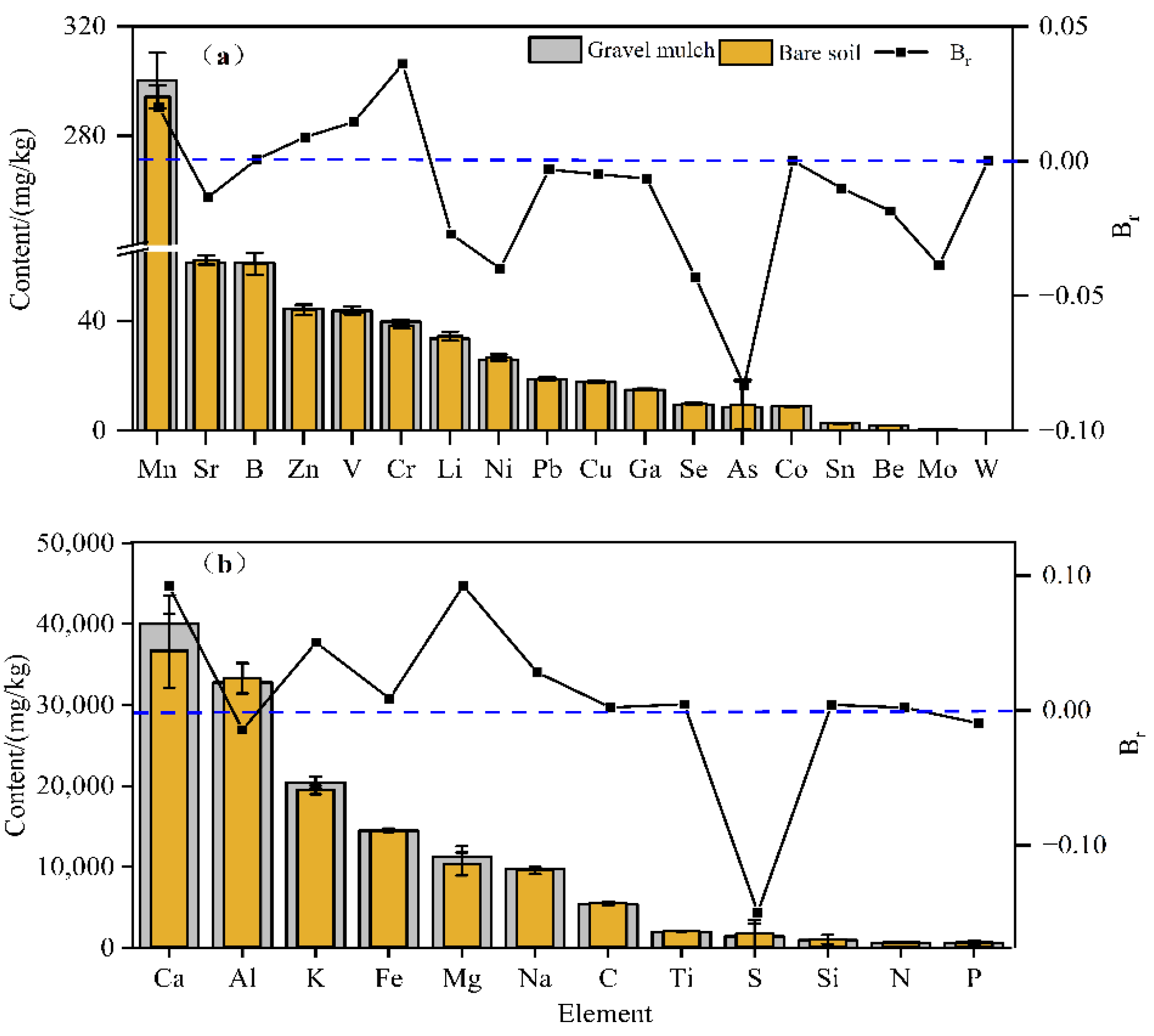
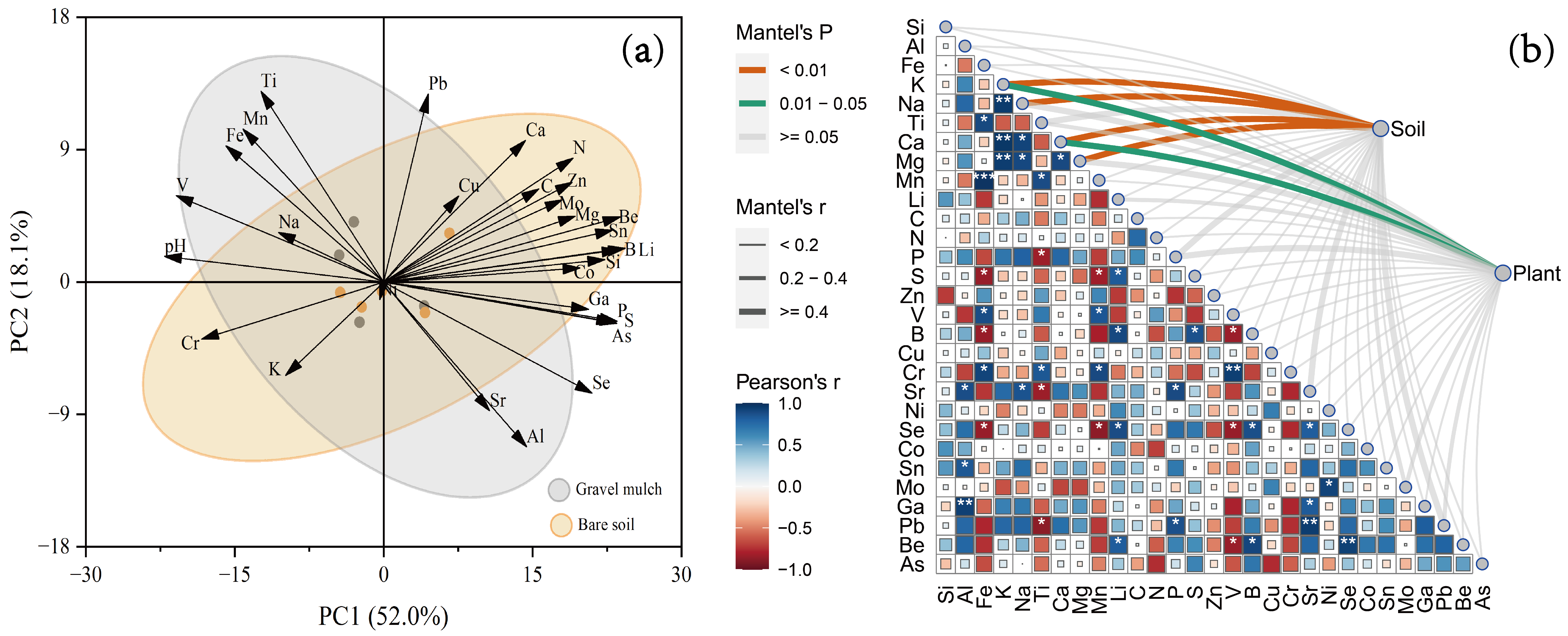
| Element | Content | RI | Element | Content | RI | ||||
|---|---|---|---|---|---|---|---|---|---|
| Water (mg/L) | Gravel (mg/kg) | Soil (mg/kg) | Water (mg/L) | Gravel (mg/kg) | Soil (mg/kg) | ||||
| Si | 4.4 | 348,614.8 | 894.6 | 389.7 | Zn | — | 122.9 | 48.0 | 2.6 |
| Al | — | 105,915.6 | 31,750.0 | 3.3 | V | 0.0 | 108.5 | 52.4 | 2.1 |
| Fe | — | 42,136.9 | 21,234.5 | 2.0 | Cr | — | 86.9 | 7.8 | 11.1 |
| K | 4.0 | 29,531.5 | 10,591.5 | 2.8 | Sr | 0.6 | 84.3 | 17.9 | 4.7 |
| Na | 31.9 | 8463.2 | 1060.4 | 8.0 | B | 0.1 | 94.6 | 36.5 | 2.6 |
| Ti | — | 4208.4 | 803.9 | 5.2 | Cu | — | 94.3 | 125.6 | 0.8 |
| Ca | 37.0 | 3549.1 | 46,567.1 | 0.1 | Ni | — | 76.5 | 24.5 | 3.1 |
| Mg | 24.4 | 1373.1 | 12,822.6 | 0.1 | Se | — | 21.6 | 9.9 | 2.2 |
| Mn | — | 472.7 | 510.9 | 0.9 | Co | — | 15.3 | 8.6 | 1.8 |
| Li | 0.0 | 89.4 | 23.9 | 3.7 | Sn | — | 14.3 | 0.4 | 40.1 |
| W | 0.0 | 4.6 | 0.0 | — | Mo | 0.0 | 1.7 | 1.1 | 1.5 |
| C | 1.2 | 14,800.4 | 5620.2 | 2.6 | Ga | — | 40.8 | 13.5 | 3.0 |
| N | 1.0 | 1600.6 | 611.5 | 2.6 | Pb | — | 35.8 | 0.9 | 41.6 |
| P | — | 686.9 | 697.8 | 1.0 | Be | — | 5.4 | 16.5 | 0.3 |
| S | 10.7 | 213.6 | 2356.5 | 0.1 | As | — | 4.7 | 11.2 | 0.4 |
| Treatments | Single Fruit Mass/g | Y/(kg·hm−2) | New Tip Length/cm | New Tip Thick/mm | Hanging Fruit Length/cm | Hanging Fruit Thickness/mm |
|---|---|---|---|---|---|---|
| BW1 | 11.8 ± 0.8 d | 2113.6 ± 31.6 c | 44.2 ± 6.0 d | 5.5 ± 0.4 c | 20.1 ± 0.7 d | 1.4 ± 0.1 e |
| BW2 | 14.0 ± 0.3 c | 2600.2 ± 156.7 b | 55.2 ± 3.9 cd | 5.9 ± 0.4 c | 21.6 ± 0.9 cd | 1.4 ± 0.1 de |
| BW3 | 15.1 ± 0.4 b | 2595.9 ± 99.5 b | 56.3 ± 6.9 c | 7.0 ± 0.2 b | 23.7 ± 1.3 c | 1.6 ± 0.1 cd |
| GW1 | 14.1 ± 0.2 c | 2790.0 ± 33.2 b | 67.0 ± 10.0 cd | 7.3 ± 0.5 b | 21.1 ± 2.1 cd | 1.6 ± 0.1 bc |
| GW2 | 16.2 ± 0.4 a | 3244.7 ± 53.6 a | 75.6 ± 4.5 b | 9.4 ± 0.4 a | 28.9 ± 1.2 b | 1.7 ± 0.1 ab |
| GW3 | 16.0 ± 0.3 ab | 3037.7 ± 110.2 a | 84.5 ± 7.2 a | 9.4 ± 0.9 a | 32.8 ± 1.1 a | 1.8 ± 0.1 a |
Publisher’s Note: MDPI stays neutral with regard to jurisdictional claims in published maps and institutional affiliations. |
© 2022 by the authors. Licensee MDPI, Basel, Switzerland. This article is an open access article distributed under the terms and conditions of the Creative Commons Attribution (CC BY) license (https://creativecommons.org/licenses/by/4.0/).
Share and Cite
Liu, Q.; Li, Y.; Li, W.; Su, Q.; Ma, B.; Mu, M.; Jia, Z.; Zhao, G. Effect of the Release of Gravel Elements on Soil Nutrients and Jujube Fruit Yield under Wet-and-Dry Cycles. Agronomy 2022, 12, 2881. https://doi.org/10.3390/agronomy12112881
Liu Q, Li Y, Li W, Su Q, Ma B, Mu M, Jia Z, Zhao G. Effect of the Release of Gravel Elements on Soil Nutrients and Jujube Fruit Yield under Wet-and-Dry Cycles. Agronomy. 2022; 12(11):2881. https://doi.org/10.3390/agronomy12112881
Chicago/Turabian StyleLiu, Qiaoling, Yangyang Li, Wangcheng Li, Qikun Su, Bo Ma, Min Mu, Zhenjiang Jia, and Guangxing Zhao. 2022. "Effect of the Release of Gravel Elements on Soil Nutrients and Jujube Fruit Yield under Wet-and-Dry Cycles" Agronomy 12, no. 11: 2881. https://doi.org/10.3390/agronomy12112881





